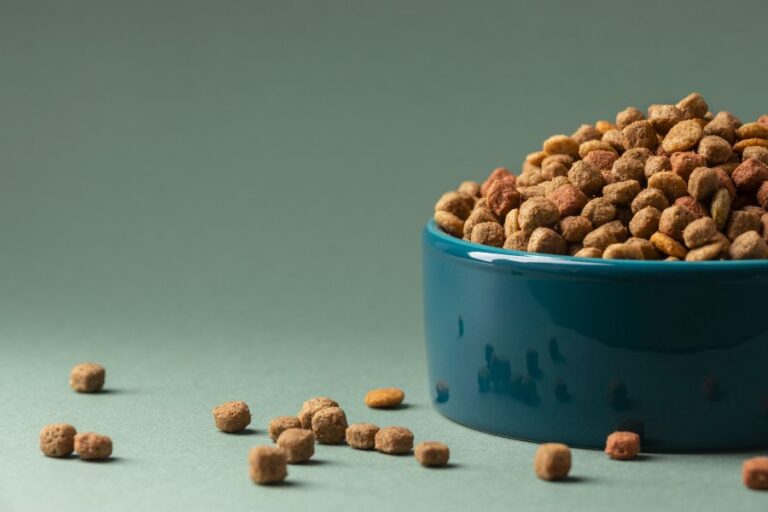Dry vs Wet Dog Food
- Last updated on April 13, 2023
- By: Caroline Stowe
As pet owners, we all want to give our furry friends the best nutrition possible. One question that always comes up is whether to feed dry or wet food.
While both options have their pros and cons, deciding which one to choose can be overwhelming.
In this post, we’ll explore the differences between dry and wet dog food, and help you decide which is better for your beloved pup.

What You Need To Know About Dry Food
Dry food, also known as kibble, is the most commonly fed type of food to dogs. Dry dog food offers many benefits, some of these benefits include the following.
Advantages of Dry Dog Food
Shelf Life
Dry dog food has a much longer shelf life than other types of dog food like wet food. This means that you can buy big bags of dry dog food and have it last for months, which is more cost-effective than other types of pet food.
Convenience
Dry dog food is easy to store and serve. You can keep it in an airtight dog food container, and it doesn’t require any refrigeration. When it’s time to feed your dog, you can simply scoop out the desired amount and serve.
Dental Health
Chewing on dry dog food helps to keep your pet’s teeth clean and healthy. The texture of dry dog food helps to remove built-up plaque and tartar, which can lead to dental issues like gum disease and tooth decay.
Nutritional Value
Dry dog food is formulated to provide your furry friend with all the necessary nutrients they need to live a healthy life. Many brands of dry dog food contain the right balance of protein, carbohydrates, vitamins, and minerals needed for a healthy diet.
Cost-Effective
Dry dog food provides great value for money, as it is typically cheaper than other types of pet food, like wet dog food. This means that you can feed your furry friend well without breaking the bank.
Easy to Transport
If you’re traveling with your pet, dry dog food is much easier to transport than other types of pet food. You can simply pack a bag of dry dog food and not worry about it spoiling or leaking.
Variety
There are many different brands and flavors of dry dog food to choose from, so you can find one that your pet loves. You can also switch up the brand or flavor if your pet gets bored with their current food.

No Mess
Unlike wet dog food, dry dog food doesn’t make a mess when your pet eats it. There are no spills or drips to clean up, making mealtime much easier for pet owners.
Long-Lasting
Because dry dog food has a longer shelf life, you can stock up on it and not worry about it going bad. This means that you always have a supply of pet food on hand for your furry friend.
Digestibility
Most dry dog food is highly digestible, meaning that it’s easy for your pet to break down and absorb the nutrients. This can help dogs with digestive issues or sensitive stomachs to maintain a healthy weight and feel better overall.
Precautions With Dry Food
Although dry dog food has many benefits you should be mindful of the quality of dry food you’re feeding your pup.
Some cheaper brands contain excessive amounts of carbohydrates, fillers, preservatives, and artificial additives that may not be healthy for your pet.
Make sure to read the ingredient list and choose a quality brand that contains the right balance of protein, healthy fats, fiber, vitamins, and minerals.
What You Need To Know About Wet Food
Wet food, also known as canned food, is a popular option for dogs who have trouble eating or digesting dry food, have dental issues, or simply prefer the taste and texture of wet food.

Advantages of Wet Dog Food
Increased Hydration
Wet dog food usually contains 70-80% water, which helps keep your dog hydrated. This is particularly important for dogs that do not consume enough water on their own. Hydration is vital for optimal cellular function in your dog’s body.
Improved Palatability
Wet dog food is generally more palatable than dry dog food. If your dog is a fussy eater or has trouble chewing hard kibbles, wet dog food might be a better option.
The soft texture and flavorful aroma make wet dog food easier for dogs to eat and enjoy.
Better Nutrient Absorption
Wet dog food is easier to digest than dry dog food. The wet food’s soft texture and high moisture content helps to break down food for better nutrient absorption.
This is particularly beneficial for dogs with digestive problems or those with sensitive stomachs.
Better for Dental Health
Wet dog food is easier on your dog’s teeth than dry dog food. The wet food’s soft texture can help prevent teeth from chipping or breaking.

The water content in wet food also helps to loosen plaque and tartar, keeping your dog’s teeth and gums healthy.
More Variety
Wet dog food comes in a wide variety of flavors, textures, and protein options, including beef, chicken, lamb, and fish.
This variety ensures that your furry friend has access to different nutrients and helps to prevent boredom with their diet, which can lead to refusal to eat.
Suitable for Dogs with Allergies
Wet dog food usually contains fewer additives, preservatives, and fillers, making it a better option for dogs with allergies or food sensitivities.
You can even find wet dog food options that are grain-free, gluten-free, and free from other ingredients that commonly cause allergies.
Ideal for Senior Dogs
As dogs’ age, their appetite and ability to digest food decreases. Wet dog food is therefore an excellent choice for dog with bad/missing teeth as well as for senior dogs who may have difficulty chewing or digesting hard food. It is easier to consume and digest, enabling senior pets to receive the necessary nutrients without straining.
Aids Weight Management
Wet dog food has fewer calories than dry dog food, making it an excellent choice for weight management.
Wet dog food contains fewer fillers than dry dog food, which means a dog can consume less food to achieve the same caloric intake and stay fuller for more extended periods.
Perfect for Dogs with Medical Conditions
Dogs with certain medical conditions, such as diabetes or kidney disease, can benefit from wet dog food. Wet dog food contains limited ingredients and allows you to manage your dog’s intake of proteins, carbohydrates, and other vital nutrients.

Better for Puppies
Puppies require more calories and nutrients than adult dogs. Wet dog food is more palatable and easier to digest, ensuring that your puppies receive the necessary nutrients while growing.
Precautions With Wet Dog Food
Wet dog food, despite its many benefits, is more expensive, has a shorter shelf life, and can be messy to store and feed.
Combining Dry and Wet Food
Many pet owners choose to feed a combination of dry and wet food to their dogs to balance the convenience, affordability, and nutritional value of both options.
This can be done by mixing a few tablespoons of wet food with dry food or alternating between the two types of food. However, it’s important to make sure that the total amount of food does not exceed your dog’s daily calorie requirement.
Additionally, you may need to adjust the portion sizes if you notice weight gain or loss.
Factors to Consider When Choosing Between Dry Or Wet Dog Food
When it comes down to deciding between wet or dry dog food for your pet, there are a few key factors you should consider first. Some of these factors include the following.
Cost
One of the significant factors to consider when deciding between dry or wet dog food is the cost. Dry dog food is generally more affordable compared to wet dog food.
Wet dog food comes in individual servings that can be more expensive in the long run, while dry dog food can be purchased in bulk and last longer with proper storage.
Consider your budget for feeding your dog as this will affect your choice.
Health Concerns
Another essential factor to consider is your dog’s health concerns. Wet dog food can be beneficial for dogs with dental problems or missing teeth, as it is easier to chew and swallow than dry dog food.
Wet dog food typically includes more protein and fat, making it ideal for dogs that require a higher calorie intake.
On the other hand, dry dog food keeps teeth clean and is less likely to stick to fur, making it better for dogs that are prone to dental problems or digestive issues.
Convenience
Convenience is another significant factor to consider when deciding between dry and wet dog food.
Wet dog food often requires refrigeration after opening and can be challenging to store, especially for pet owners with limited freezers or storage space.
Dry dog food, on the other hand, has a longer shelf life and can be easier to measure out and store.
Dog Preference
Your dog’s preference is also a significant factor to consider. Some dogs may have a preference for either wet or dry food, and their preference should be taken into account.
If your dog enjoys wet food, it could be challenging to switch them to dry food, and vice versa. Consider your dog’s preference when selecting its food.
Nutritional Value
Lastly, consider the nutritional value of the food you are providing your dog. Wet dog food tends to have higher moisture content and more protein and fat, while dry dog food often has more carbohydrates.
Check the labels carefully to ensure you are choosing a high-quality dog food that will meet all your dog’s nutritional needs.
Determining Which Is Better For Your Dog
The best food for your dog can vary depending on their age, weight, breed, health condition, and activity level. You should consult with your veterinarian to determine what type of food will meet your dog’s specific needs.
In general, younger dogs may do better on dry food as it helps strengthen their teeth and jaws, while elderly dogs or those with dental issues may benefit from the moisture and texture of wet food.
Additionally, dogs with medical conditions such as obesity, diabetes, or kidney disease may require a specialized diet that consists of either dry or wet food.
Check out what veterinarians advise you on this question. Click the video link below.
Conclusion
In conclusion, the decision of whether to feed dry or wet food ultimately comes down to your personal preference as well as your dog’s unique needs.
Both options have their advantages and disadvantages, therefore, it is important to find the right balance to ensure that your pup is getting all the nutrients they need while also enjoying their meals.
Remember to read the ingredient lists, choose quality brands, and consult with your vet if you have any questions or concerns. By providing your furry friend with a balanced and nutritious diet, you’re ensuring that they will live a long and healthy life by your side.
Ultimately, the best way to decide is to talk with your veterinarian and experiment with different varieties of dry and wet dog food until you find the right fit for your pup.
-
Author: Caroline Stowe
- Updated on April 13, 2023
Disclaimer: This article doesn’t intend to replace professional veterinary advice, nor should it be used as a substitute for veterinary services, diagnosis, or treatment. The content on this website, including information and opinions expressed herein, are intended for general informational purposes only. In case you have concerns or questions regarding your dog’s health and diet requirements, please consult your veterinarian before doing anything that might affect it.
DogPetGuide.com and the writer are not responsible or liable for any damage, liability, costs, or claims arising from any possible consequences of the reader’s action after reading this article.




